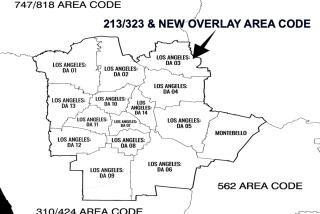CULTURE WATCH : Deciphering the Codes
- Share via
If Arizona’s area code is 602, and neighboring Nevada’s is 702, then 802 must be . . . Vermont?
It is, if the logic belongs to the North American Numbering Plan Administration.
With area codes, any resemblance to a pattern is purely unintentional. The goal is to make neighboring codes as different as possible to minimize confusion, says Ron Conners, who directs the Numbering Plan for Bellcore, the New Jersey-based research arm of the nation’s major phone companies. (Oh, like Arizona and Nevada? Or Arkansas, 501, and Mississippi, 601?). It doesn’t always work, he says.
With California adding 909 in November (for portions of Riverside, San Bernardino and Los Angeles counties) and New York, Canada and Michigan snapping up 917, 416 and 810, respectively, the only choice left is 910.
(The codes must have a 1 or 0 as the middle digit so that telephone equipment recognizes the call as long distance. There are 152 possibilities.)
In 1995, all long-distance calls will have to be preceded by dialing a 1, which already is the case in California and many other states. With a 1 in front, any three-number combination can serve as an area code. That will allow another 640 permutations, Conners says.
What happens when the new combinations run out? Conners shudders. The traditional seven-digit phone number will be lengthened, meaning everyone will get a new number. But it probably won’t happen until everyone reading this article is dead and buried.
More to Read
Sign up for Essential California
The most important California stories and recommendations in your inbox every morning.
You may occasionally receive promotional content from the Los Angeles Times.













